This hasn't been the productive week at the easel which I had intended to put in. All sorts of little things such as family affairs, administrative matters, the funeral of an old friend and, in particular, the lack of suitable light for painting, kept getting in the way. The sun has been a stranger, a thick layer of cloud having covered the islands for most of the time. The wind has been strong, mostly from the south-east, which means that a heavy sea has been running into Breiwick Bay. This is particularly noticeable today, and the lifeline ferry "Hjaltland" is still at anchor in Kirkwall Bay, Orkney, as I write this. According to Ship AIS, her ETA at Lerwick is 2pm, but she certainly won't be making that now. The other ferry "Hrossey" left Lerwick on her southward journey about an hour ago, and a glance out my window reveals the Streamline container ship "Daroja" just approaching the harbour, about four hours later than her usual Sunday arrival time.
What little work I've achieved this week has been on the Boyndie Bay painting, which is now nearing completion in spite of the spasmodic nature of my artistic output. I hope to have the finished picture on display here at some point during the next few days. When I do, your comments, as always, would be very welcome!
The Grumpy Old Artist
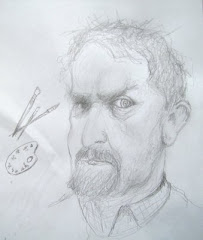
Would YOU pose for this man???
Exhibition Poster

Catterline Event, 2011
Oil Painting by Jim Tait
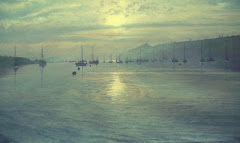
Helford River, Cornwall
Oil Painting by Jim Tait
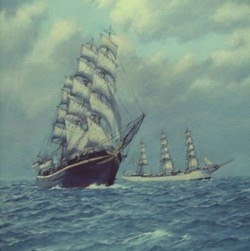
Full-riggers "Georg Stage" and "Danmark"
Other Recent Works
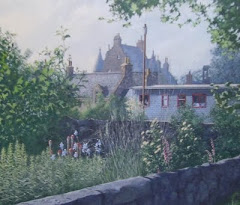
Fordyce Castle and Village

Hay's Dock, Lerwick

Shetland-model Boats at Burravoe, Yell
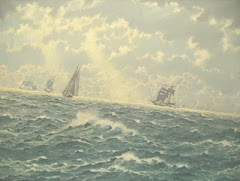
Tall Ships Seascape

The Tour Boat "Dunter III", with Gannets, off Noss
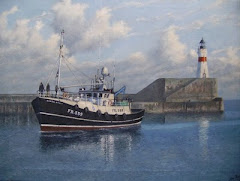
The "Karen Ann II" entering Fraserburgh harbour
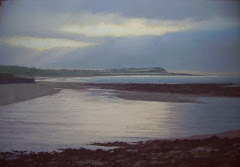
Summer Evening, Boyndie Bay
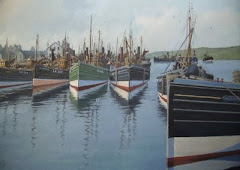
1930s Lerwick Harbour

Johnshaven Harbour
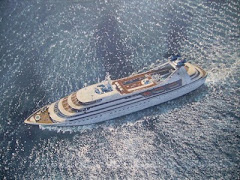
"Seabourn Legend"
Greeting Cards!

Now Available in Packs of Five or in Assorted Sets of Four
Sunday, 25 October 2009
HERE ENDETH THE FIRST CHAPTER.....
My apologies are due to the French postal authorities, who were on the end of a tongue-lashing in my last post. Not that they ever saw my posting (very few people do!), or were particularly bothered, supposing they did - these large corporations tend to be quite pachydermal.
The package containing my painting arrived back chez moi safely yesterday, having spent a month on a journey to, from and presumably around France, although it never reached its intended destination in Provence. The contents seem to be in good condition, in spite of having attracted the attention of HM Revenue and Customs en route. Perhaps they mistook my bubble wrap and polystyrene sheeting for a consignment of best hashish - who knows? In a way, I suppose I have to be smugly satisfied with my own wrapping system, which has survived this prolonged trip.
The main mystery is how my address envelope got torn off during this odyssey. I used one of these clear purpose-built "Documents Enclosed" thingies (and yes, I remembered to peel the back off first!). This has completely disappeared, leaving a puckered hole in the wrapping at the top left corner of where it used to be. Why didn't it adhere better?
These and other questions have been buzzing around my tortured mind this morning, as I have been filling in the Parcelforce claim form for my postage and insurance. "Doo haes ta git whit doo can!", as my uncle Tirval used to say. If anyone wants a translation of that snippet of Shetland vernacular, email me at jim@tait-gallery.co.uk.
I've kept in touch with the client to whom the package had been addressed (fortunately he is a patient man) during this sorry episode, and we have agreed that it would be better to wait until the postal strike is over before we attempt another despatch. We thereby avoid any unnecessary complications to a process which is already frought with difficulties. I'll let you know how we get on!
The package containing my painting arrived back chez moi safely yesterday, having spent a month on a journey to, from and presumably around France, although it never reached its intended destination in Provence. The contents seem to be in good condition, in spite of having attracted the attention of HM Revenue and Customs en route. Perhaps they mistook my bubble wrap and polystyrene sheeting for a consignment of best hashish - who knows? In a way, I suppose I have to be smugly satisfied with my own wrapping system, which has survived this prolonged trip.
The main mystery is how my address envelope got torn off during this odyssey. I used one of these clear purpose-built "Documents Enclosed" thingies (and yes, I remembered to peel the back off first!). This has completely disappeared, leaving a puckered hole in the wrapping at the top left corner of where it used to be. Why didn't it adhere better?
These and other questions have been buzzing around my tortured mind this morning, as I have been filling in the Parcelforce claim form for my postage and insurance. "Doo haes ta git whit doo can!", as my uncle Tirval used to say. If anyone wants a translation of that snippet of Shetland vernacular, email me at jim@tait-gallery.co.uk.
I've kept in touch with the client to whom the package had been addressed (fortunately he is a patient man) during this sorry episode, and we have agreed that it would be better to wait until the postal strike is over before we attempt another despatch. We thereby avoid any unnecessary complications to a process which is already frought with difficulties. I'll let you know how we get on!
Labels:
H M Revenue and Customs,
painting,
Postal system,
wrapping
Sunday, 18 October 2009
CECI EST UN CHRONO-POST!
I thought that I would add this footnote to my last week's post, in which I explained, in fairly forthright terms, my dilemma with regard to the sending of a painting to France.
Parcelforce are now doing their best to locate this parcel, and have allocated an employee called Sharon to attend to the problem. I wish her good fortune in her endeavours.
In the meantime, Chronopost Roissy, the firm in whose hands the package was last located, have contacted the person to whom I was sending it, and have informed him that they are sending it back to me. Yeah! Why, for goodness's sake (they obviously have his contact details), couldn't they just have delivered it to him, which is what they were paid to do in the first place? I smell a big French rat here - some pitiful attempts at setting up a smokescreen around the fact that they have lost the parcel, and they are hoping that they can just cover up the whole thing.
But if they think they can do that, they don't know me very well - n'est ce pas?
Parcelforce are now doing their best to locate this parcel, and have allocated an employee called Sharon to attend to the problem. I wish her good fortune in her endeavours.
In the meantime, Chronopost Roissy, the firm in whose hands the package was last located, have contacted the person to whom I was sending it, and have informed him that they are sending it back to me. Yeah! Why, for goodness's sake (they obviously have his contact details), couldn't they just have delivered it to him, which is what they were paid to do in the first place? I smell a big French rat here - some pitiful attempts at setting up a smokescreen around the fact that they have lost the parcel, and they are hoping that they can just cover up the whole thing.
But if they think they can do that, they don't know me very well - n'est ce pas?
Labels:
Chronopost Roissy,
lost in the post,
smokescreens
THE VILLAGE OF FORDYCE
I hope you like my most recent painting, a landscape featuring a view of Fordyce Castle from a back garden in the village, of the same name, situated a few miles south of Portsoy, on the Moray Firth coast of Scotland. This is the first of a series of works in which I am making the fatal mistake of trying to evoke the memories and sensations of summer evenings driving round this lovely part of the country earlier this year.
While the Fordyce painting is full of finnicky and time-consuming detail, the work currently on my easel contains large empty areas of sand, sea and sky. It is of Boyndie Bay, looking from Banff to Whitehills, and it is less demanding of my fine-point brushes, but I hope it will be no less effective.
I am also doing my first re-cycling of one of the paintings from my Duff House exhibition earlier this year. It was a portrayal of a fishing vessel running before a gale, and will shortly be of the passenger/cargo ship "St. Ninian" in similar sea conditions.
While the Fordyce painting is full of finnicky and time-consuming detail, the work currently on my easel contains large empty areas of sand, sea and sky. It is of Boyndie Bay, looking from Banff to Whitehills, and it is less demanding of my fine-point brushes, but I hope it will be no less effective.
I am also doing my first re-cycling of one of the paintings from my Duff House exhibition earlier this year. It was a portrayal of a fishing vessel running before a gale, and will shortly be of the passenger/cargo ship "St. Ninian" in similar sea conditions.
Labels:
evocations of summer,
Fordyce,
landscapes
Thursday, 15 October 2009
GATHERINGS
My brother arrived, on the Northlink ferry last Saturday, on one of his occasional northward sojourns, to see his mother and siblings, and to breathe the sweet air of his birthplace for a little while. Whenever he comes north, the two of us usually take a trip down to Sandwick, to attend the morning service in our old church, and just to take a look at the old parish. While looking from a distance, it looks pretty much like it did when we were residents there; on closer inspection it has changed practically beyond recognition in the thirty-five years or so since we stayed there as a family. There are several new housing schemes there, and many private homes have also been built. Many of the little wild places, which I enjoyed as a child, have been reseeded or built on. The Broonies' Taing pier, on which I regularly wafted my "piltock waand" to catch copious quantities of coalfish, was one of the first casualties of the oil era. It was redeveloped, along with all the ruinous old pre-war herring stations which were a wonderful playground for a growing boy, as an oil industry supply base which, in the event, was hardly ever used as such. It is now rotting, like the herring stations before it. The only time I ever visit the old place is when Arthur is home - I could cry whenever I look at it.
On this occasion, we visited our father's grave at the Sannock cemetery, which is looking well-tended and has plenty of room to cater for new tenants for at least the next century, even allowing for an outbreak of plague or genocide (anything is possible in Sandwick!). We attended the service in the U. F. kirk, which turned out to be their harvest thanksgiving. This had brought about two dozen of the faithful from their beds on a bright chilly morning. My brother rang the bell to announce the service, and I'd like to think that a few more ears would have inclined and a few more bleary eyes would have opened in the community at the unfamiliar sound - apparently the bell is only rung if he rings it.
After the service, we took a run down to the compact settlement of Hoswick, where the only sign of life was a family playing on the beach. We then came back to Stove, where we found our nephew Kenneth (who had taken a weekend off from his studies at university) resting from his home-refurbishing labours at Victoria House, the Edwardian pile he inherited from his father. He made us a welcome cup of tea before we continued on our way to Whiteness, where we were to have our midday meal with other family members at our mother's house.
I helped prepare the feast by doing the vegetables, and we all enjoyed our roast lamb with trimmings. My sister Mary was in charge of the catering operation, and we were joined by her daughter Caroline and grandsons Robbie and new baby William, who slept through most of our joviality. I took charge of the ensuing clearing-up afterwards and, within an hour, were it not for the satisfied feeling in our stomachs, we would scarcely have known that the meal ever took place. In the late afternoon, Arthur ran me back to Lerwick in the car he had hired for his short stay.
There was a certain inevitability about the fact that the next day was Monday, and the day on which the twice-yearly meeting to dicuss my mother's care package was scheduled. These bunfights are usually fairly relaxed and pleasant affairs, and resultant serious injuries are rare. On this occasion, my two available sisters (the third is teaching in Saudi Arabia), my brother, my mother (of course), two representatives of the home care authorities, and myself were of the assembled company in my mother's living room. There was little to discuss, as the system is working smoothly, and, after half-an-hour or so, the meeting ended and I was left to prepare a meal for the family (a look of abject terror came over the faces of the two care representatives when I suggested that they stayed for lunch - I took this to be a "no"!).
From the sound of contented mastication emanating from the diners, I deduced that my culinary efforts had been successful again. I had prepared whiting fillets, cut up into sections and fried in batter, accompanied by potatoes (from my sister's garden) and melted margarine - an example of the standard traditional Shetland fare which we, as a family, were raised on. After clearing up, I helped Arthur with the task of pruning the rose-bushes in the greenhouse, after which we took the prunings to the dump at Rova Head, and he dropped me off at my flat, before making his way back to Whiteness.
My brother will be heading south on the ferry "Hjaltland" tonight, and his leaving will make me sad, as these things always do. We who are left will dig ourselves in for another Shetland winter. It would be nice to think that we'll all meet up again when the gales die down and the snow clears at the other end of it. We have always had such a good time together.
On this occasion, we visited our father's grave at the Sannock cemetery, which is looking well-tended and has plenty of room to cater for new tenants for at least the next century, even allowing for an outbreak of plague or genocide (anything is possible in Sandwick!). We attended the service in the U. F. kirk, which turned out to be their harvest thanksgiving. This had brought about two dozen of the faithful from their beds on a bright chilly morning. My brother rang the bell to announce the service, and I'd like to think that a few more ears would have inclined and a few more bleary eyes would have opened in the community at the unfamiliar sound - apparently the bell is only rung if he rings it.
After the service, we took a run down to the compact settlement of Hoswick, where the only sign of life was a family playing on the beach. We then came back to Stove, where we found our nephew Kenneth (who had taken a weekend off from his studies at university) resting from his home-refurbishing labours at Victoria House, the Edwardian pile he inherited from his father. He made us a welcome cup of tea before we continued on our way to Whiteness, where we were to have our midday meal with other family members at our mother's house.
I helped prepare the feast by doing the vegetables, and we all enjoyed our roast lamb with trimmings. My sister Mary was in charge of the catering operation, and we were joined by her daughter Caroline and grandsons Robbie and new baby William, who slept through most of our joviality. I took charge of the ensuing clearing-up afterwards and, within an hour, were it not for the satisfied feeling in our stomachs, we would scarcely have known that the meal ever took place. In the late afternoon, Arthur ran me back to Lerwick in the car he had hired for his short stay.
There was a certain inevitability about the fact that the next day was Monday, and the day on which the twice-yearly meeting to dicuss my mother's care package was scheduled. These bunfights are usually fairly relaxed and pleasant affairs, and resultant serious injuries are rare. On this occasion, my two available sisters (the third is teaching in Saudi Arabia), my brother, my mother (of course), two representatives of the home care authorities, and myself were of the assembled company in my mother's living room. There was little to discuss, as the system is working smoothly, and, after half-an-hour or so, the meeting ended and I was left to prepare a meal for the family (a look of abject terror came over the faces of the two care representatives when I suggested that they stayed for lunch - I took this to be a "no"!).
From the sound of contented mastication emanating from the diners, I deduced that my culinary efforts had been successful again. I had prepared whiting fillets, cut up into sections and fried in batter, accompanied by potatoes (from my sister's garden) and melted margarine - an example of the standard traditional Shetland fare which we, as a family, were raised on. After clearing up, I helped Arthur with the task of pruning the rose-bushes in the greenhouse, after which we took the prunings to the dump at Rova Head, and he dropped me off at my flat, before making his way back to Whiteness.
My brother will be heading south on the ferry "Hjaltland" tonight, and his leaving will make me sad, as these things always do. We who are left will dig ourselves in for another Shetland winter. It would be nice to think that we'll all meet up again when the gales die down and the snow clears at the other end of it. We have always had such a good time together.
Labels:
church bells,
Family Gatherings,
home parish
Wednesday, 14 October 2009
LOST IN FRANCE
I believe that this was a Bonnie Tyler hit - it sounded like her well-gravelled emotional voice which belted out the lyrics of this song. I've been humming it intermittently all day, not because I've any particular liking for the Welsh vocalist or her music, but because of the song-title's aptness in my present situation.
You see, the painting, which was commissioned by my friend and regular client Magnus Schmidt, which I have spent the last three months producing, and which I had placed in the hands of Royal Mail's Parcelforce, on 28th September, for shipment to Provence, was last heard of in a depot belonging to Chronopost Roissy on 2nd October. Since then, it has disappeared.
I had insured the parcel for a sum which I felt was reasonable to compensate me for its possible loss, and I will make "bien sur" that I am compensated financially, at least, but what gets my goat is that I will now have to spend another three months producing a replacement artwork for my client. This time could have been spent on my next exhibition, for instance. The person who is responsible for the disappearance of this painting has stolen three months of my life, and I am annoyed about that. I don't know how many productive three-month periods of life are left to me, and I don't want to spend any of them repeating myself - I do enough of that during conversations with drunks and bureaucrats. And the nagging notion that a summer's work may have gone to provide a fix for a sticky-fingered French junkie isn't improving my mood at the moment.
I promise I'll be in a better frame of mind for my next post.
You see, the painting, which was commissioned by my friend and regular client Magnus Schmidt, which I have spent the last three months producing, and which I had placed in the hands of Royal Mail's Parcelforce, on 28th September, for shipment to Provence, was last heard of in a depot belonging to Chronopost Roissy on 2nd October. Since then, it has disappeared.
I had insured the parcel for a sum which I felt was reasonable to compensate me for its possible loss, and I will make "bien sur" that I am compensated financially, at least, but what gets my goat is that I will now have to spend another three months producing a replacement artwork for my client. This time could have been spent on my next exhibition, for instance. The person who is responsible for the disappearance of this painting has stolen three months of my life, and I am annoyed about that. I don't know how many productive three-month periods of life are left to me, and I don't want to spend any of them repeating myself - I do enough of that during conversations with drunks and bureaucrats. And the nagging notion that a summer's work may have gone to provide a fix for a sticky-fingered French junkie isn't improving my mood at the moment.
I promise I'll be in a better frame of mind for my next post.
Sunday, 4 October 2009
ARTISTIC LABOURS
The only artistic achievement I can lay claim to since my last post was the completion of the commissioned painting of the Whalsay seine-netter "Orion" in a Lerwick harbour being caressed by a fresh southerly breeze. I am pleased with the work, which is shown above for your delectation!
I have heard the news, from the Musa Art Cafe in Aberdeen, that none of my paintings on display there have sold, but the resident piano player has recognised his grandfather's fishing boat in one of my harbour scenes. In the absence of sales, I find this encouraging!
I have continued work on the Fordyce village landscape, which is going to be another manifestation of my recently-acquired interest in small details. Is this a further indication of a compulsive-obsessive nature, or merely a sign of the patience which accompanies approaching old age? Who knows? I don't think I displayed a great deal of patience in my last posting.
I seem to have developed a headache. Where's the paracetamol?
I have heard the news, from the Musa Art Cafe in Aberdeen, that none of my paintings on display there have sold, but the resident piano player has recognised his grandfather's fishing boat in one of my harbour scenes. In the absence of sales, I find this encouraging!
I have continued work on the Fordyce village landscape, which is going to be another manifestation of my recently-acquired interest in small details. Is this a further indication of a compulsive-obsessive nature, or merely a sign of the patience which accompanies approaching old age? Who knows? I don't think I displayed a great deal of patience in my last posting.
I seem to have developed a headache. Where's the paracetamol?
WIND!
Just a minute - aaah, that's better! It's amazing how a bit of wind release can benefit one's heart, body and frame of mind, isn't it? There's certainly been a lot of wind, of one kind and another, generated in these islands of late, along with quite a lot of heat and slightly less light, much of it in connection with the proposed Viking Energy windfarm which, if constructed, would affect the skyline of much of the central mainland of Shetland.
It appears that a considerable majority of the Shetland population is opposed to it, and I, in my usual curmudgeonly manner, am swimming against a strong tide of public opinion in my conviction that the proposed development should take place, and that these islands will live to regret its rejection. I have several reasons for holding this belief.
Shetland's economy is fragile. The oil industry, which has served Shetland so well as an employer of islanders, is not going to last forever - oil and gas are finite resources (unlike wind!). Even taking into account the new fields in the Atlantic, which have extended the life of the Sullom Voe Terminal far beyond its original projected lifespan, the well of employment generated by the oil industry will dry up, as far as these islands are concerned. The future of other major employers, such as the fishing and fish farming industries, is equally uncertain. The former is under attack from the very body which should be supporting it, the EU, as well as the effects of climate change and fleet effort on stocks. The latter is subject to infectious diseases and uncertain markets, and many businesses engaged in this activity have already gone under. This leaves small indigenous traditional industries such as knitwear, croft-based electronic ventures, crofting itself and tourism (Lord help us!). We need a new source of income and employment which, if managed properly at the Shetland end, can keep these islands in the manner to which we have become accustomed over the past few decades. Wind is a natural resource of which Shetland has never been in short supply, and it is all wonderfully renewable! The abundance of this commodity has been the main feature of Shetland's meteorology over the centuries, to the extent that it has cost hundreds of lives, chiefly, but not exclusively, at sea. Having had it operating for so long against us, why not have it working for us, for a change?
The Shetland Islands Council organised several public meetings, at various locations throughout the Shetland mainland, during the past week, for the purpose of having the views of the population aired on the subject of the proposed development. At each of these meetings, none of which I am ashamed to say I attended, a vote was taken which, without exception, was firmly against the windfarm. Many of the objections were (perversely, in my opinion) on environmental grounds. The turbines, if built, would be situated on the hilly ridges which run the length of much of the mainland of Shetland. The surface of these hills is comprised almost entirely of varying depths of peat, and this, it is true, provides a habitat for a large variety of waders and other ground-nesting birds. But peatland is not exactly in short supply in these islands. My back develops a psychosomatic ache whenever I think of the hours spent toiling in the stuff during my formative late springs and summers at the south mainland parish of Sandwick.
Please forgive me for beginning to beat my drum against "colonial incomers" here again. One woman, who spoke at one of last week's meetings, stated that the one reason she settled here was to look at the unspoilt views of the place, and, if the windfarm development was to go ahead in its present form, she'd leave. Well, if she only came here to gawp at the scenery, please don't let me detain her! The representatives of other single-interest groups uttered their objections too. One speaker mentioned the possible failure of breeding populations of birds, not caring to mention his lack of concern for the economic wellbeing of the next generation of Shetlanders. If all human enterprise is to be sacrificed on the altar of ornithological interests, the prospects are poor for the working communities of Shetland. The dictatorial "scientific"and wildlife organisations, whose lobbies (drawing most of their support from the urban areas of Britain) are much more powerful than those of Shetlanders working at traditional (and new) industries, would be quite happy to see Shetland reduced to a kind of hippy colony (it's how many see us anyway!), in which the only people earning a decent living are social workers and drug dealers.
Many of the objections raised to the windfarm development are financial. It is going to cost an awful lot of money, let's face it, to build this scheme, but the benefits must surely outweigh the large initial outlay, and it is down to our negotiators to get a good deal for the Shetland power-consumer at the outset, so that he or she will be able to go to his or her cheaply-powered warm bed at night, with a clear conscience as to the source of his or her comfort, which, in turn, is having little negative effect on the global environment. And will these hilltop turbines be such an awful blot on the landscape?
It appears that a considerable majority of the Shetland population is opposed to it, and I, in my usual curmudgeonly manner, am swimming against a strong tide of public opinion in my conviction that the proposed development should take place, and that these islands will live to regret its rejection. I have several reasons for holding this belief.
Shetland's economy is fragile. The oil industry, which has served Shetland so well as an employer of islanders, is not going to last forever - oil and gas are finite resources (unlike wind!). Even taking into account the new fields in the Atlantic, which have extended the life of the Sullom Voe Terminal far beyond its original projected lifespan, the well of employment generated by the oil industry will dry up, as far as these islands are concerned. The future of other major employers, such as the fishing and fish farming industries, is equally uncertain. The former is under attack from the very body which should be supporting it, the EU, as well as the effects of climate change and fleet effort on stocks. The latter is subject to infectious diseases and uncertain markets, and many businesses engaged in this activity have already gone under. This leaves small indigenous traditional industries such as knitwear, croft-based electronic ventures, crofting itself and tourism (Lord help us!). We need a new source of income and employment which, if managed properly at the Shetland end, can keep these islands in the manner to which we have become accustomed over the past few decades. Wind is a natural resource of which Shetland has never been in short supply, and it is all wonderfully renewable! The abundance of this commodity has been the main feature of Shetland's meteorology over the centuries, to the extent that it has cost hundreds of lives, chiefly, but not exclusively, at sea. Having had it operating for so long against us, why not have it working for us, for a change?
The Shetland Islands Council organised several public meetings, at various locations throughout the Shetland mainland, during the past week, for the purpose of having the views of the population aired on the subject of the proposed development. At each of these meetings, none of which I am ashamed to say I attended, a vote was taken which, without exception, was firmly against the windfarm. Many of the objections were (perversely, in my opinion) on environmental grounds. The turbines, if built, would be situated on the hilly ridges which run the length of much of the mainland of Shetland. The surface of these hills is comprised almost entirely of varying depths of peat, and this, it is true, provides a habitat for a large variety of waders and other ground-nesting birds. But peatland is not exactly in short supply in these islands. My back develops a psychosomatic ache whenever I think of the hours spent toiling in the stuff during my formative late springs and summers at the south mainland parish of Sandwick.
Please forgive me for beginning to beat my drum against "colonial incomers" here again. One woman, who spoke at one of last week's meetings, stated that the one reason she settled here was to look at the unspoilt views of the place, and, if the windfarm development was to go ahead in its present form, she'd leave. Well, if she only came here to gawp at the scenery, please don't let me detain her! The representatives of other single-interest groups uttered their objections too. One speaker mentioned the possible failure of breeding populations of birds, not caring to mention his lack of concern for the economic wellbeing of the next generation of Shetlanders. If all human enterprise is to be sacrificed on the altar of ornithological interests, the prospects are poor for the working communities of Shetland. The dictatorial "scientific"and wildlife organisations, whose lobbies (drawing most of their support from the urban areas of Britain) are much more powerful than those of Shetlanders working at traditional (and new) industries, would be quite happy to see Shetland reduced to a kind of hippy colony (it's how many see us anyway!), in which the only people earning a decent living are social workers and drug dealers.
Many of the objections raised to the windfarm development are financial. It is going to cost an awful lot of money, let's face it, to build this scheme, but the benefits must surely outweigh the large initial outlay, and it is down to our negotiators to get a good deal for the Shetland power-consumer at the outset, so that he or she will be able to go to his or her cheaply-powered warm bed at night, with a clear conscience as to the source of his or her comfort, which, in turn, is having little negative effect on the global environment. And will these hilltop turbines be such an awful blot on the landscape?
Labels:
Shetland,
traditional industries,
wind,
Wind energy,
wind turbines
Subscribe to:
Comments (Atom)








